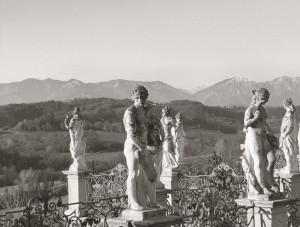Le Colture. Fagher. Prosecco di Valdobbiadene. (DOC).
Brut. Az agr. Colture. (Ruggeri).
The family have owned their vineyards since the 1500s. All the grapes come from their own vineyards. They own approximately 45 ha. They produce about 520,000 bottles per annum. There are three generations of the family involved in the business and they changed the name in 1983 to distinguish it from a large producer whose name is, confusingly, Ruggeri.
Borgoluce. Prosecco di Valdobbiadene. DOC. Brut.
Borgoluce is part of the huge estate of Tenuta Collato which owns approximately 1500 hectares in the region of Valdobbiadene-Conegliano. The grapes for their wines come from the hills between Valdobbiadene, Susegana and Collalto (even if the wine label suggests that the wine comes from Valdobbiadene alone). The estate encompasses agriturismo, along with farm produce such as cattle, pigs, flour and nuts. The Castello di San Salvatore, once home to the Collalto family (they own it still but no longer live there) is one of the most historic and beautiful architectural landmarks in all of the Veneto.
Bisol Wine Estate. Crede. Prosecco di Valdobbiadene. DOC. Brut.
Bisol own more than 45 hectares situated at altitudes above 250m. However, they also buy in grapes sufficient to produce some 1.4m bottles per annum across their range. The family have been viticulturists in Valdobbiadene since 1542. Part of their estate includes agriturismo and they are soon opening another on the island of Mazzorbo (Burano).
¶
The most reknown area for Prosecco is the DOC Prosecco di Conegliano-Valdobbiadene. Unlike many other types of wine, Prosecco is the name of a grape variety and not a region. This is a problem for its producers in that under European law, names of varietals do not receive any protection as to usage. Thus a winemaker in Puglia is entitled to name their wine Prosecco (if they use the varietal). This is why it is important to identify the producer making sure that the DOC region is mentioned on the label. In order to make Prosecco di Conegliano-Valdobbiadene, which can be either sparkling or semi-sparkling, the grapes must come exclusively from the area identified by law and vinification can only take place in one of the 15 communes of the DOC zone. The prise de mousse and bottling may only be carried out in the province of Treviso.
Prosecco vines from here are only grown on the south-facing slopes of the hills at an altitude of 50 - 500 metres (approx. 165 - 1650 ft.) above sea level. The production zone covers an area of approximately 4,800 hectares (approx. 9,750 acres) of cultivated land. The steep slopes of the hills make it difficult to mechanically harvest the grapes. Consequently managing the vineyards has almost always been left in the hands of the 5,000 producers, most of whom are small growers. Since the beginning of the 19th century, with the founding of the School of Viticulture and Oenology and The Experimental Centre for Viticulture, both located in Conegliano, research into this vine variety and technology of making spumante from Prosecco has been significant. The particular types of soils, the south-facing hills, the rainy summer climate with mild temperatures from April to October and big changes in temperature between night and day during the maturity period, are the ideal conditions to produce this elegant wine with its unique fruity and floral aroma. In the vineyards of the DOC area, there are other grape varieties, in addition to Prosecco, such as Verdiso, Perera and Bianchetta. These varieties are used to balance the flavour of the Prosecco and may only account for 15% (maximum) of the overall wine produced. Verdiso: used to increase the sapidity but also acidity (especially in hot years). Perera, for its perfume and thus aroma (mainly in Valdobbiadene) and the Bianchetta which ripens earlier than some of the grapes and can be grown in some of the higher and less accessible zones.
Harvesting is done by hand. A long fermentation with locally selected yeasts gives the wine a mild alcoholic content and makes it fresh with a fruity and floral aroma. These characteristics will be developed in the second fermentation by the Charmat method, which is used for the production of sparkling wines. The first fermentation provides wines of 9.5% alcohol. The spumatisazone gives the balance of the alcohol.
Prosecco is a hardy and vigorous vine producing quite large, loosely packed bunches. The grapes themselves are a bright yellow colour and the wine varies between a very pale yellow through to a topaz yellow.

Cartizze is the most sought after zone for growing Prosecco grapes and the area was already known for its excellent wine in the 14th century. The grapes are left to be harvested after they have already begun to shrivel slightly. This intensifies their flavours and natural sugars. The special area of Cartizze is no more than 104 hectares and most of these are owned by small producers.










